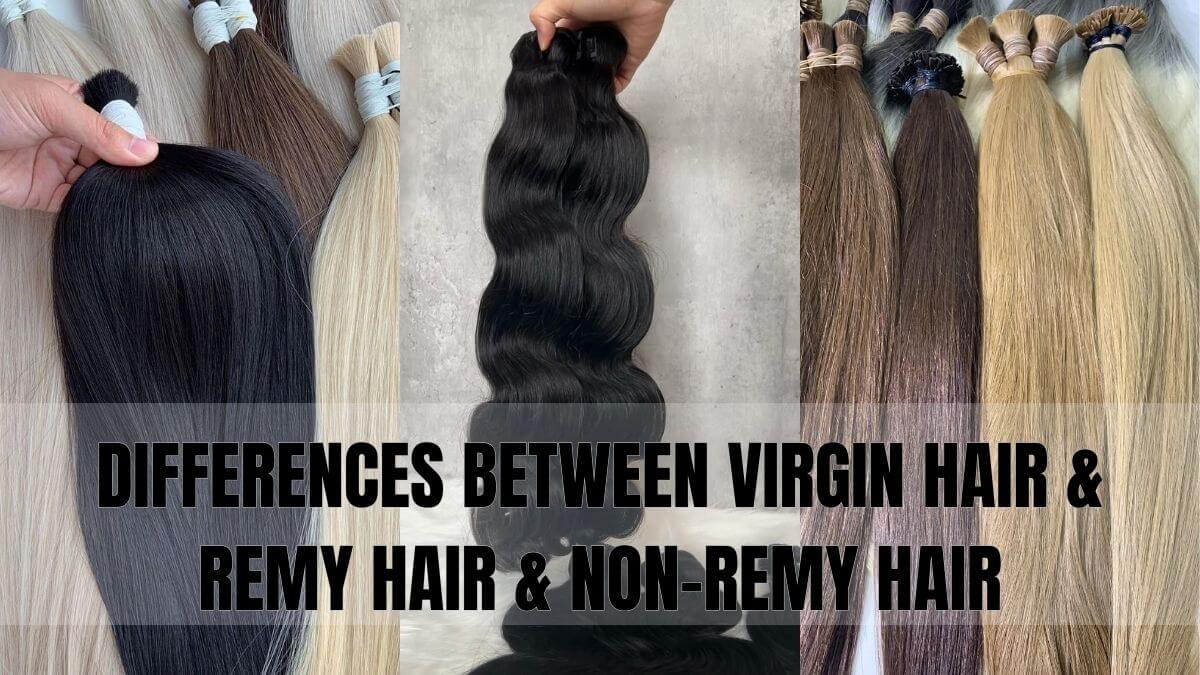Confused about Virgin Hair & Remy Hair & Non-Remy Hair? Discover their key differences in quality, processing, durability, and pricing.
Deciding what type of human hair to use for wigs or extension pieces can be daunting, especially with so many options available today. However, Virgin Hair & Remy Hair & Non-Remy Hair are the most popular types of hair used, and each offers different levels of quality, durability, and price.
In this article, discover the ins and outs of their differences to help you decide which type best suits your hair needs.
Contents
1. What is Virgin Hair & Remy Hair & Non-Remy Hair?
While shopping for hair wigs and extensions, understanding the different types of human hair is essential. There are three major categories, which include: Virgin Hair, Remy Hair, and Non-Remy Hair. Each has its characteristics, value, and pricing. Knowing the differences helps buyers choose what fits their needs and budget.
- Virgin hair is the best type of human hair. It has the softest texture and the most durability. Unlike non-virgin hair, it is collected from a single donor who has not undergone chemical treatments like dyeing, perming, and bleaching. Its natural texture and cuticle alignment are preserved, making it extremely soft and long-lasting.
- Remy Hair has gone through minimal steam treatment and coloring. Like Virgin hair, Remy Hair is also collected with the natural cuticle alignment being preserved from root to tip, which means the hair’s cuticle is still intact. As a result, the hair tangles less and lasts longer.
- Non-Remy Hair is gathered from different suppliers without paying attention to the cuticle direction, meaning it has gone through heavy chemical processes. This type of hair is coated with silicone to enhance its shine. However, it has the highest possibility of tangling and shedding quickly because of the misplaced cuticles.
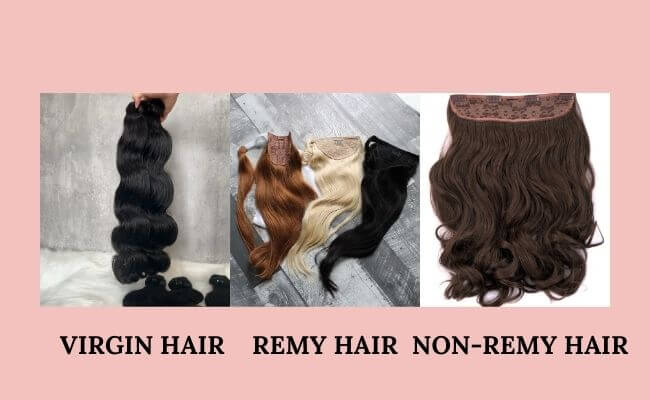
2. Key differences between Virgin Hair, Remy Hair, and Non-Remy Hair
All three types of hairs are widely accepted and utilized in the hair industry but differ greatly in quality, processing, and durability. Below is a breakdown of the most important factors that set them apart.
2.1. Hair collection method
Collecting hair is an art. The way it is gathered determines its quality and subsequently price.
- Virgin Hair: Virgin Hair is collected with great care from a single donor. As the hair is cut, every strand is cut in an aligned manner. This method ensures the strands remain intact and aligned, just as they were before being cut.
- Remy Hair: Remy Hair may come from multiple donors, but it’s collected in a way that keeps the cuticles aligned to reduce tangling.
- Non-Remy Hair: Non-Remy Hair is collected in bulk from numerous sources, including salons, hairbrushes, and other mixed sources. As a result, this hair undergoes massive changes to prevent the hair from getting tangled easily.
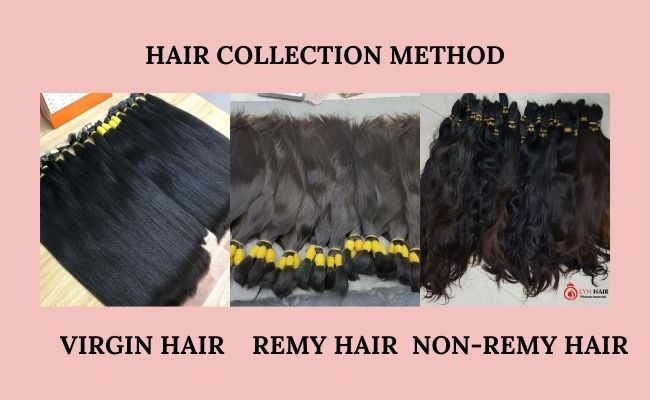
2.2. Processing & Treatment
In comparison to Remy hair and Virgin hair, the processing and treatment methods of hair Non-Remy Hair differ the most.
- Virgin Hair: Because Virgin Hair is too pure, it has not been dyed, permed, or chemically treated in any way. Doing so would damage a hair’s natural durability and texture.
- Remy Hair: It is very common for Remy Hair to go through some form of color treatment or steam treatment to change how it looks or the texture of it. Even with light processing, the cuticles remain intact.
- Non-Remy Hair: Non-Remy Hair undergoes the most changes, including removing the cuticles, coating the hair with silicone, and treating it with chemicals to improve its shine and create a smooth finish. However, in the long run, the silicone shine diminishes.
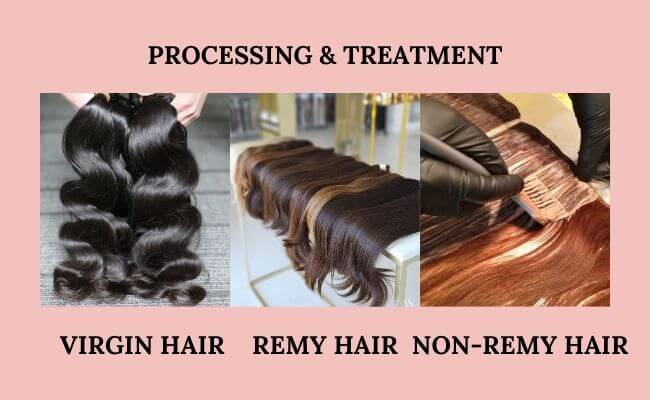
2.3. Quality & Longevity
Hair extensions last differently depending on the type of hair used and how well it is taken care of.
- Virgin Hair: For virgin hair, quality can be maintained for years as it remains soft and natural. Because it’s untreated, the quality stays high for a long time.
- Remy Hair: Remy Hair is durable and maintains quality with proper care. Aligned cuticles help prevent excessive shedding and tangling which enables this hair to last a year or more.
- Non-Remy Hair: Non-Remy hair tends to have a lower quality lifespan out of all three options. After a few months, Non-Remy Hair often becomes tangled and loses its shine. Hair then becomes rough and damaged once the silicone coating fades.
2.4. Appearance & Texture
The feel and look of the set of extensions differ depending on the type as seen above.
- Virgin Hair: Virgin Hair’s naturally soft and silky texture makes it ideal for styling, coloring, and long-term wear.
- Remy Hair: Remy Hair has a smooth, natural appearance and blends easily with real hair enabling it to retain shine. There may be slight measures of processing done which makes the hair look as such.
- Non-Remy Hair: Non-Remy Hair appears glossy due to the silicone coating, but over time, it becomes dull and prone to tangling.
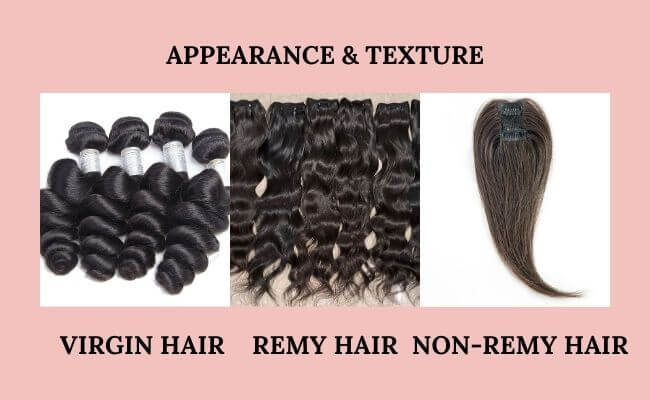
Conclusion
Understanding the differences helps you choose based on quality, budget, and maintenance needs. Always remember to consider your future demands when buying hair extensions or wigs. If high quality and longevity are what you are after, Virgin Hair or Remy Hair would be suitable options. For short-term spending or budget-friendly options, Non-Remy Hair may suffice, but it does require extra care to maintain its appearance—especially when worn in public.

